Science Fiction Books
By Nick Broadhurst
There are twenty-three science fiction books in the first Sequetus Series. These twenty-three books are grouped into four miniseries. Originally the books were to be only the first eight books in what is now called the New Earth Miniseries. But as soon as the series finished, new ideas began for the next book, and so it went on for twenty-three books. And when the twenty-third book was finished, those ideas did not stop, they continued. So the author deliberately put down his keyboard, and yet the ideas have been there every day for six years waiting for him to start typing again. And so he did.

The first two books of the Sequetus Sequel have been written.
The books were always written in a manner so they could be continued, and continued, right from the very start. The glossary then became bigger and bigger with each new volume. In the end it became an entire book, Book 24, the Compendium.
The Sequetus Series then became four miniseries. It then included Captain Kuro From Mars, a twelve book series for children. Now the first two books of the sequel are written.

The books took decades to write. There may be more decades yet too. The story is not over. Not by any means.
Children’s Picture Books
Author: Nick Broadhurst
Illustrator: MD Hasib Uzzaman
The idea of the children’s book evolved in Canberra. Nick even went to a local writers’ class on how to write children’s picture books. The series took about five years to complete, a lot longer than anticipated.
The artist, Hasib, was first found by the author on Fiverr. After the first two books were illustrated, Hasib ceased freelancing on Fiverr.com. Nick knew he lived in Bangladesh and after a few weeks Hasib was located and he agreed to continue with the series. We took the next few years to complete writing the story and illustrating it. The last five books were written while the author was in Florida.
Like writers, Hasib had a slightly different name to his own and the last name on his works, Uzzaman, and Uzerman, are interchangeable in English.
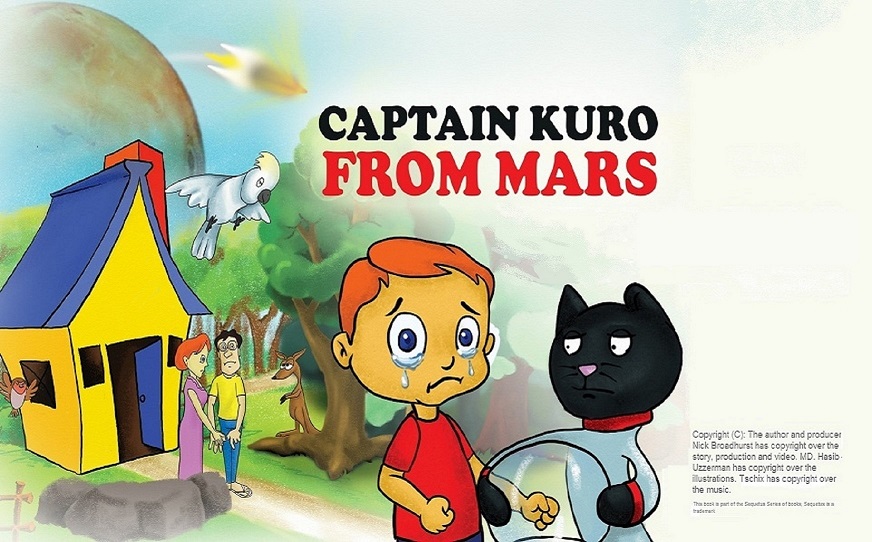
Hasib showed a lot of willingness and talent. He researched his subject well. He captured the Australian bush setting in his illustrations, and got teh characters right, even down to their footwear. His illustrations are done by hand and there are over three hundred of them in total.
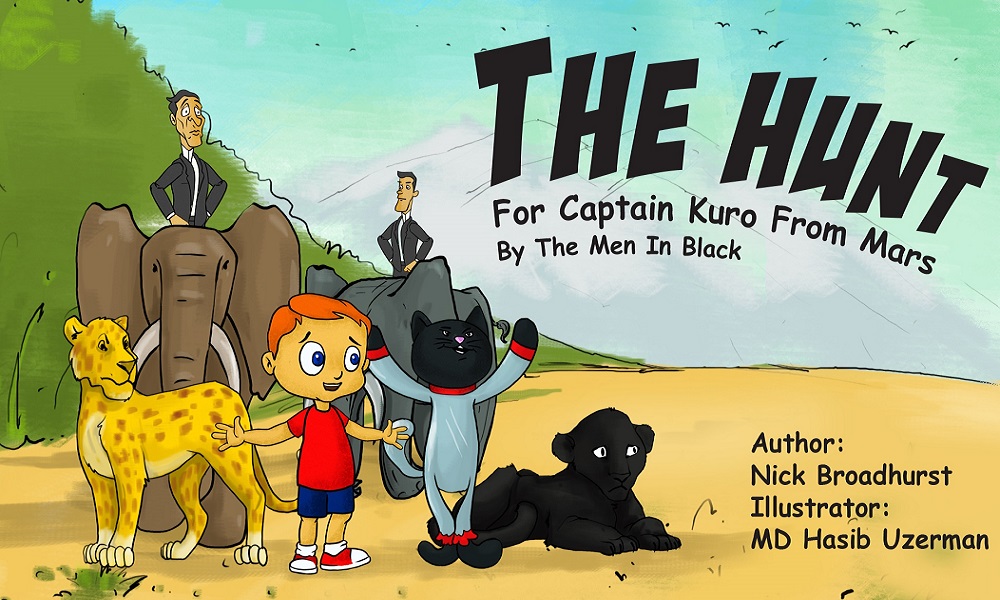
The books were first written in Canberra, Australia. Then they were continued in Kathmandu. The author was studying Sanskrit there, among other things. The last five books were written in the USA. But the production for the latter books was done in Kathmandu.
The comics came about as an offshoot to the picture books. The comic strip booklets were created by the author, which Hasib created the more modern looking superhero magazines type comics.
The first story, Captain Kuro From Mars, was translated into sixty languages by the author as he wanted the world to know that it was one and Captain Kuro was going to teach them all, regardless of the nation, culture and language. If ideas are transmitted with telepathic thought, then words as sounds are perhaps secondary to the ideas. So in this series, Captain Kuro has developed the spiritual ability to be able to communicate on thought levels alone. That in theory could mean that words are not that needed. So, the story went out in sixty languages.
The author speaks basically English. Yes, he learned German school. he learned Japanese when he lived in Tokyo for ten years. he even learned some Swedish from his first wife decades ago. And he learned a few words in Chinese after working in Taiwan and having visited there a dozen times. Then in Nepal he studied Sanskrit wile at the national university there. That in itself was an amazing experience as he learned so much about language. The language, Sanskrit, an old language, is referred to as the mother of all languages. It is obviously the parent language to a lot of Latin and this English. The learning here was not just the language but how it moved around the world. Oh, and the word for Black is Kuro,as Kuro is a Japanese word for Black. But funnily enough, black can be also kuro in Sanskrit. Captain Kuro From Mars is available in Sanskrit.
Children’s Comics
There are two versions of the Children’s Comics. The first was created by the author and they are for selling to other websites so they can also put the story of Captain Kuro From Mars out there. The story is a good story and the series teach children good wholesome ideas. It will be the children of the world who save it and so they must have good values to start with.
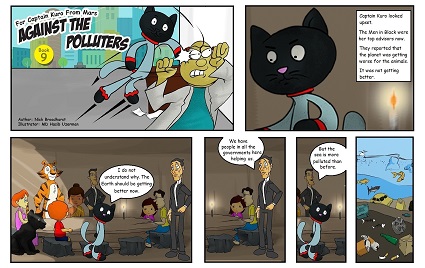
The illustrator, Hasib, came up with the second idea for the comics in his superhero styled books. These are very different in style and will work for different aged readers. All the dies of the original picture books are available in the comic versions.
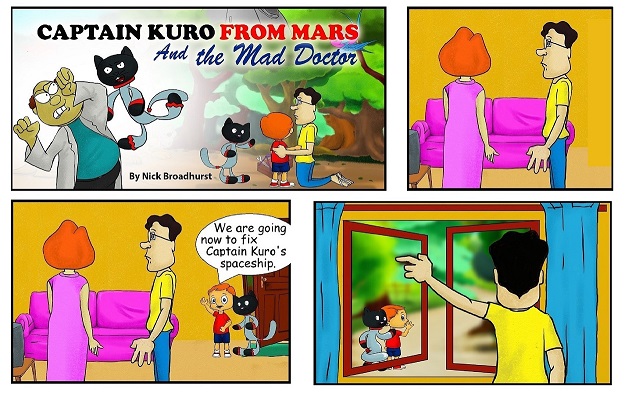
Musical Soundtracks
The author first met the wife of the musician, Tschix, in Japan in 1993. About nine of the books were written by Nick while he lived in Tokyo. There he met Nefeli. She was the manageress of a publishing house in Japan. She reviewed the manuscripts for the author. Both the author and Nefeli knew each other professionally, and there was this book link between them.
Years later they happened to communicate again and the books came up. Nefeli loved the story still, and Captain Kuro who was new on the scene. She introduced her husband to the books. What he did with the music, inspired by the books, was magic.

Tschix is not the musician’s real name. Again, this is not uncommon for artists. He was very busy composing and writing and came up with all the music that is demonstrated in its early form on www.squetus.net. None of the tracks on the website are for sale as Tschix is producing them professionally. The tracks are there to be appreciated by readers, nothing more.
The music, per the author, is simply genius. One can feel the story through the music. There are twenty tracks in all, for both Sequetus and Captain Kuro. There is an additional song for Captain Kuro that Nefeli wrote.
Being artists there is an empathy one artist can have for another and this is demonstrated through the various arts that we have here. There is writing, there is illustrating and drawing, and there is music.
But the list of contributors are more than just these.

Articles
As Nick Broadhurst is a writer it is not unusual to expect he would write articles as well. The articles speak for themselves. They are on practical subjects that Nick knows about, such as in construction, but also in science fiction, writing, and environmental protection that he is passionate about. The same themes that run through his books also run through the articles. The articles are found in sections. Articles on philosophy are here on www.sequetus.net.
The articles were once on a dozen article sites over the internet, but most article sites closed and today there are only two significant remaining, of which Ezine Articles is still being contributed to by Nick.

The reason for the articles being put onto Nick’s own website is to preserve them. There were once many hundreds, but not now, as most of the article websites closed down.
The articles are being built and contributed to on a monthly basis. They are being added to, or supplemented to, with the Sequetus.net blogs.

Non-Commissioned Illustrations
The non-commissioned Illustrations are from two sources. The first was from the author himself. For maps and so on he simply used the old paint program on Microsoft. It is easy to use and makes good maps, and such, and Nick uses it even today. But he also sketched many scenes and ideas that he had, to see if they worked.
The very first issues of the books were on Amazon, and the early sketches can be found published on the original site, thanks to the main request of Candessa, the main proof reader. The www.sequetus.com early sketches.

The second source of these non-commissioned illustrations is www.dreamsworld.com. Here is where the book cover art came from, and the illustrations found inside the science fiction books. They are paid for and the artists involved get their royalty.
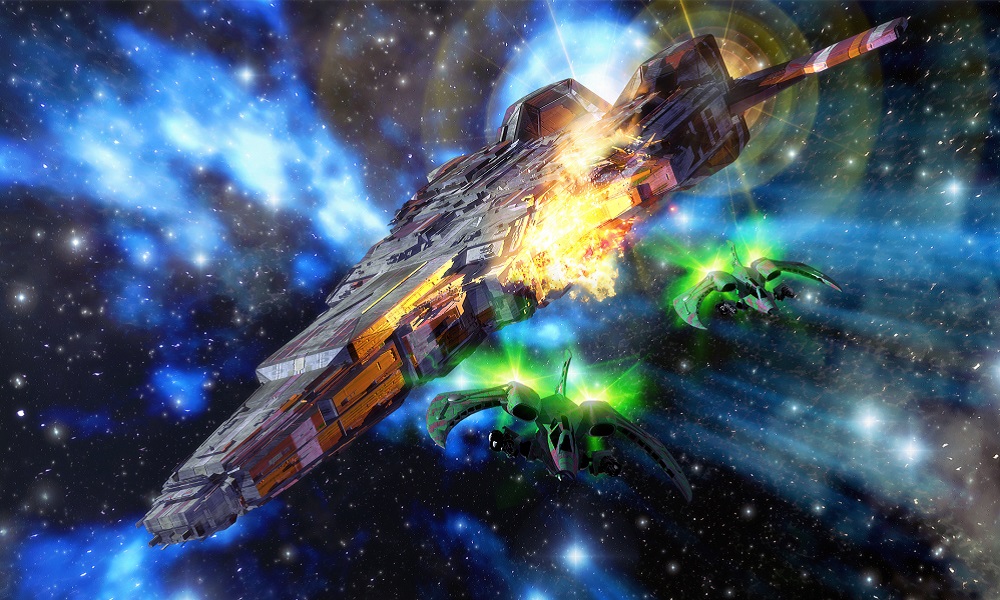
Translations of Captain Kuro From Mars
There were two main sources of translations. The first were the translations of the first two books. These were done in Canberra.
The next translations were done in Kathmandu, Nepal. Nick had help from Bimala, Anu, and Amar in translating the Captain Kuro From Mars Series into Nepali. Bimala also did the Captain Kuro From Mars Comic Strip Booklets, while Anu translated the original picture books. Amar helped on administration.
A freind in Pakistan, Arshad, translated the Urdu version of the Captain Kuro From Mars picture books.
The other languages then evolved one after the other, until a cap was put on sixty languages total.
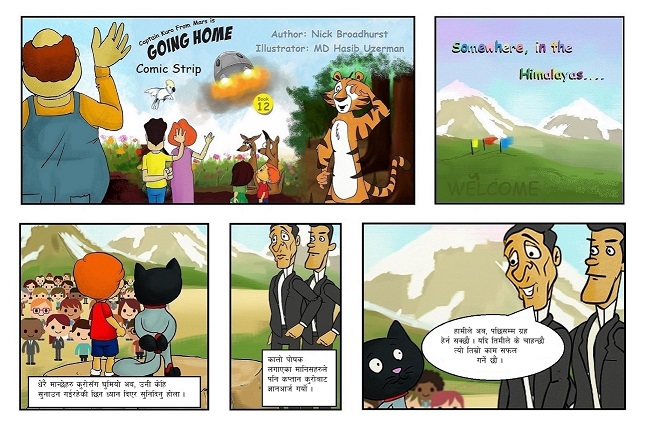
Bimala, Anu and Amar also helped on establishing a super superfood company we all engaged in: Himalayan Long Life Botanicals/ Himalayan Gold. Interesting in that this business spun off from research into the Sequetus Series where it was postulated that a person could extend his life span considerably, naturally, or even reduce his biological age. Please read the information on the other site for more on this, but both these possibilities are no longer fiction – at least as far as the author goes. These claims are no longer fiction. While the science is not explained on the above site, there is a more of it explained briefly here, on the original site www.sequetus.com in the research section. It was here, shortly after writing this, in around 2015, when the author decided to register the business Himalayan Gold, both in Australia and Nepal.
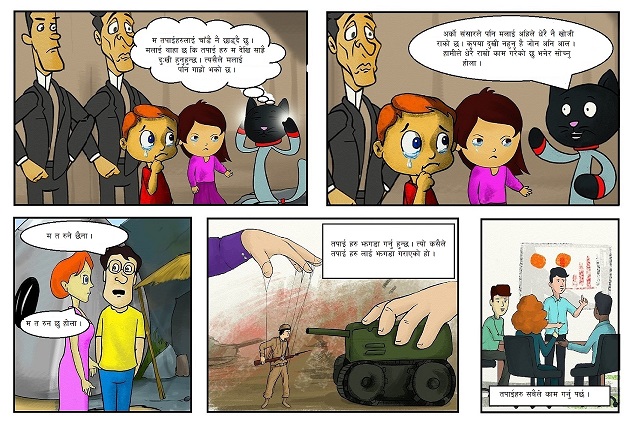
Editing of the Sequetus Series
The Sequetus series was twenty-three books. It is almost a million words in total. That is a huge possibility of many errors.
The first editing was done by Nefeli, who was really interested to read the story. Her advice was excellent and adhered to. Her advice was about the style and parameters of the story. That was in 1993. At the time there was no feedback to the author if these books were good enough, as a story to publish. Nefeli believed they were, and she worked as a manageress for a publisher, running a branch in Tokyo.
The manuscript was also given to a freind in Australia. Remember, there were no digital platforms then, and computers were very new. The freind’s wife contacted the author upset, as her husband was not able to put the manuscript down until 5 am each morning, and he was too tired to work. That sounded good, in a convoluted fashion. The author was freinds to both husband and wife. Nick was in Japan by then.

Nick’s second wife helped on the editing, and her advice was excellent. She was a public relations executive and the advice was skillful.
The third person to edit, named Candessa, was a trained editor and did it as a professional. She would read the manuscript and send it back in the editor’s manner all noted and so on. The author would fix it and it would get edited again. In all, Candessa read the series three times, not just once, and the books were read in order. After the twenty-third book was read, she read them all again from the start, and so on.
This was invaluable. One of Nick’s passions was raising intelligence in children, and he had several theories on that, and put those theories into the books. In theory, these books should raise intelligence, not just be fun to read. In addition to that Candessa also found that in reading the books a second time she would find they had a deeper meaning, and so it went like that for a third time. This was deliberately done by the author so people would get additional meanings of the work after having read the entire set of twenty-three books. It was thought that if the books were so deep the first time that people would not wade through them to get their full understanding. One needed to know the twenty-three books to get them read with deep understanding. One truly needs to know the past of Sequetus 3 to truly appreciate what is going to happen in the future.
Additionally, there are theories outlined in the books that only special people will understand. Such as Vedic scientists. People who are versed in the Veda and what it truly represents, and know how the Vedic hymns work, and who are also western scientists, they can truly understand what is in the books. This was one reason for the author staying in Nepal.
For example, can a person truly see something in the future. Yes. How? What is the mechanism in play? It is in the books. Can a person see something remotely, well out of vision. Yes, and how? It is in the books. Is it possible to travel out of time, and reappear back in a future time? Or a past time? Yes. It is in the books. But a person must read these books a few times to totally get it. And this includes the Sequetus Sequel.
So, to the professors and scientists Nick met in the university in Kathmandu, he says, thank you.


